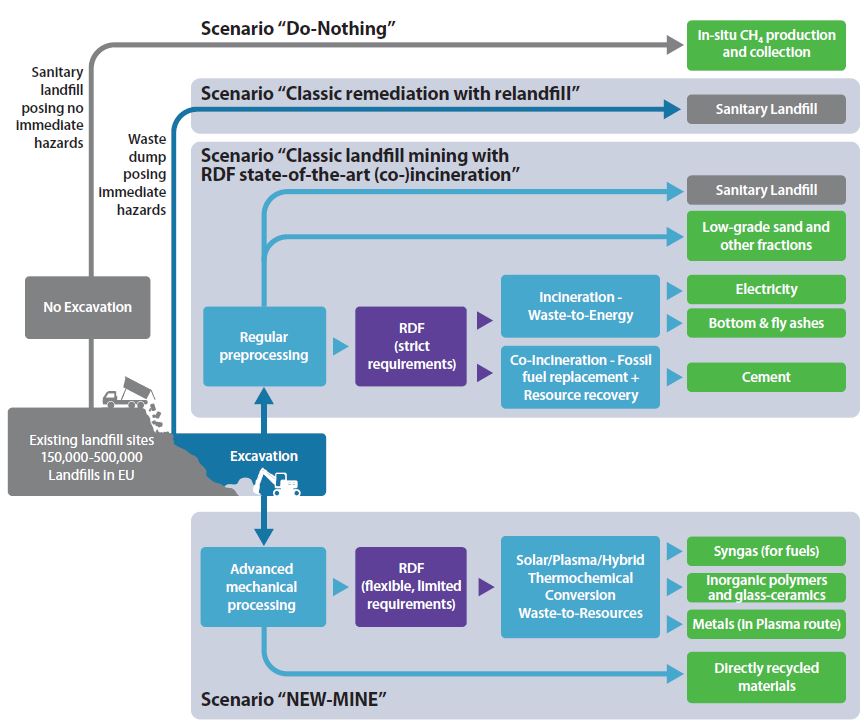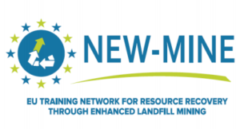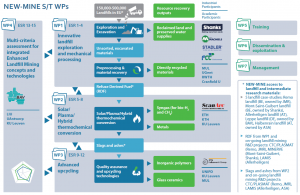The ETN NEW-MINE project is the ‘European Training Network for Resource Recovery Through Enhanced Landfill Mining’; it runs for four years from September 1, 2016 to August 31, 2020.
Project abstract
Europe has somewhere between 150,000 and 500,000 landfill sites, with an estimated 90% of them being “non-sanitary” landfills, predating the EU Landfill Directive of 1999. These older landfills tend to be filled with municipal solid waste and often lack any environmental protection technology. In order to avoid future environmental and health problems, many of these landfills will soon require expensive remediation measures. This situation might appear bleak, but it does present us with an exciting opportunity for a combined resource-recovery and remediation strategy, which will drastically reduce future remediation costs, reclaim valuable land, while at the same time unlocking valuable resources. However, the widespread adoption of Enhanced Landfill Mining (ELFM) in the EU, as envisaged by NEW-MINE, urgently requires skilled scientists, engineers, economists and policy makers who can develop cost-effective, environmentally friendly ELFM practices and regulatory frameworks. All this demands a European commitment to concerted, inter- and transdisciplinary research and innovation. NEW-MINE trains 15 early-stage researchers (ESRs) in all aspects of landfill mining, in terms of both technological innovation and multi-criteria assessments. The technological innovation follows a value-chain approach, from advanced landfill exploration, mechanical processing, plasma/solar/hybrid thermochemical conversion and upcycling, while the multi-criteria assessment methods allow to compare combined resource-recovery/remediation ELFM methods with the “Do-Nothing”, “Classic remediation” and “Classic landfill mining with (co-)incineration” scenarios. By training the ESRs in scientific, technical and soft skills, they become highly sought-after scientists and engineers for the rapidly emerging landfill-mining and broader raw-materials industries of Europe.

15 ESRs in 4 work packages
The 15 PhD topics are linked through the NEW-MINE ELFM flowsheet, subdivided in 4 work packages which each reviews a different aspect of enhanced landfill mining:
- Innovative landfill exploration & mechanical processing
- Solar/Plasma/Hybrid thermochemical conversion
- Advanced upcycling
- Multi-criteria assessment for integrated ELFM concepts and technologies
Progress beyond the state of the art
NEW-MINE develops and integrates cutting-edge, eco-friendly ELFM technologies to valorise Europe’s 150,000– 500,000 landfills, thereby recovering resources (materials, energy, land), while mitigating future environmental and health risks associated with landfills as well as avoiding enormous landfill-remediation costs. Spill-over of technologies to other sectors (E.g. treatment of fresh waste, mining sector, use of secondary raw materials in the building sector) is considered to be natural. Project results have been communicated and disseminated widely (publications, policy briefs, ELFM symposium, different video’s, etc). A project video was developed, which <as viewed, shared and liked massively on social media (over 40.000 views on Facebook alone). It can be viewed online on Youtube on: https://www.youtube.com/watch?v=8pkGfARjPao&
NEW-MINE provides training in all aspects of ELFM, not only to ESRs but also to all consortium members and external partners (e.g. through summer school). NEW-MINE ESRs are the logical employees of industry, academia and public sector in this field and contact with future employers is guaranteed already during the project through the presence of these actors within the consortium and in the broader ELFM network.
NEW-MINE is well embedded in/ and actively contributes to the growth of the network on ELFM. A strong link to national/E.U. initiatives ensures the long-term sustainability of the network. Continuation of the network is ensured by active participation of the NEW-MINE partners within the EURELCO consortium, continue to organise the International Academic Symposia on Enhanced Landfill Mining and NEW-MINE Summer Schools, engage in upscaling ELFM technologies for both MSW/USW and industrial residues, e.g. “KAVA activities” (KIC Added Value Activities) within EIT KIC Raw Materials & InnoEnergy and EIA/RIA projects in the field; organization of the second seminar on enhanced landfill mining in the European Parliament, which took place on November 20, 2018 (see https://kuleuven.sim2.be/2nd-elfm-seminar-european-parliament-2011/).
Work performed till August 31, 2018 (midterm)
Work package 1 studies innovative landfill exploration and mechanical processing of waste excavated from landfills. Excavations have taken place at the Mont-Saint-Guibert landfill in Belgium and the Halbenrain landfill in Austria. A flowsheet has been developed for the exploration, excavation and mechanical processing of the Mont-Saint-Guibert landfill in Belgium. An excavation campaign was organized at this landfill and different fractions were produced through mechanical processing. Apart from this, an excavation and MBT processing campaign at the Halbenrain landfill in Austria was followed. Activities performed include electromagnetic exploration experiments to explore the spatial distribution of different waste types within landfill sites (ESR1). Study of MBT process and ballistic separation processes for the treatment of landfill material for the production of different fractions, including “pre-RDF” (ESR2). Study of sensor based sorting on ELFM materials (ESR3). Studies of the valorisation possibilities of the fine fraction (particle size 14 mm to <90 mm) present in landfills, composing commonly > 50 % of the landfill content (ESR4).
Work package 2 studies the thermal conversion of the Refuse Derived Fuel fraction (RDF, i.e. the light fraction produced in work package 1 through mechanical processing, composed of plastics, wood, etc.), for the production of synthetic gas, ashes or vitrified ashes (depending on the thermal process) and metals. The 4 PhD topics have been linked in a novel thermal conversion process for RDF. Activities involve the study of the thermal conversion of RDF through steam plasma gasification (ESR5), the purification of syngas using plasma tar cracking (ESR6) and the use of solar power combined with thermal energy storage to be able to heat the gasification agent (ESR7-8).
Work package 3 studies the upcycling of ashes and vitrified ashes, by-products of the gasification process of WP2. ESR9 studies the vitrification of ashes, aiming at cleaning the material from any remaining heavy metals that could jeopardize valorisation. ESR 10 studies the microwave treatment of ashes to form a precursor for inorganic polymers and/or glass ceramics. ESR11 studies the synthesis of inorganic polymers from vitrified ashes. A large range of synthesis conditions was studied, resulting in a binder of adequate properties. Apart from this, lightweight materials were produced using the binder. ESR12 develops glass-ceramics from the (vitrified) ash. Glass ceramics could be produced successfully with properties comparable to ceramic tiles and natural stones.
Work package 4 develops a multi-criteria assessment for landfill mining concepts and technologies. ESR13 develops an integrated life cycle assessment (LCA) and risk assessment methodology for ELFM. ESR14 develops a techno-economic assessment model for ELFM. ESR15 looks at policy and market interventions for facilitation of ELFM implementation. An integrated assessment is being developed by joint-work of the three ESRs. Base scenarios have been defined and investigated and data collection is in progress.


